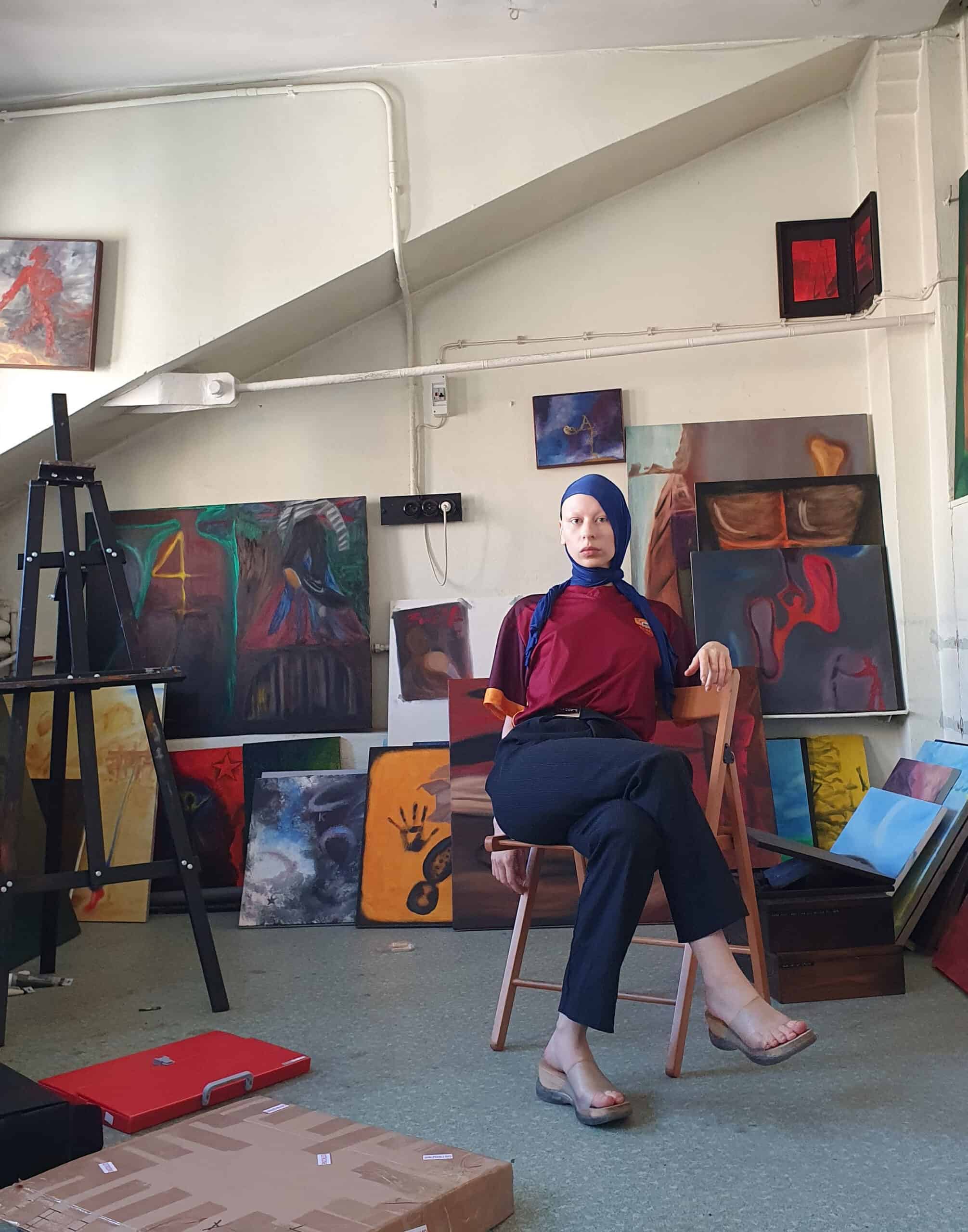
Zuzanna Bartoszek
Adam Mazur: What is the difference between writing poems and painting?
Zuzanna Bartoszek: My approach to both is similar, and I derive much joy from both. One can write whenever and wherever. Not so with painting, which requires organisation, time, financial resources to maintain a studio, paints. I haven’t managed to set up a proper studio yet. I paint on a hopelessly rickety easel. However, a painting can be sold for a good sum, whereas nobody wants to read or publish poems.
AM: That is a very practical consideration. I mean, your understanding of synaesthesia, as we have it from Modernism. From your perspective, it is like an energy flow between text and image.
ZB: Ideally, I would only write about that which cannot be painted, and paint only that which cannot be written about. But it is not always so. Occasionally, a thought or feeling can give rise to both a painting and a poem. What emerges depends only on my impetus.
AM: Can you elaborate on this?
ZB: I feel that my consciousness does not reach that which determines what I will create. I don’t want to sound insane like there’s no difference, or that painting is like eating and writing is like sex, or something like that. I really and truly do not know what the difference is between painting and writing when it comes to what precedes the creative process.
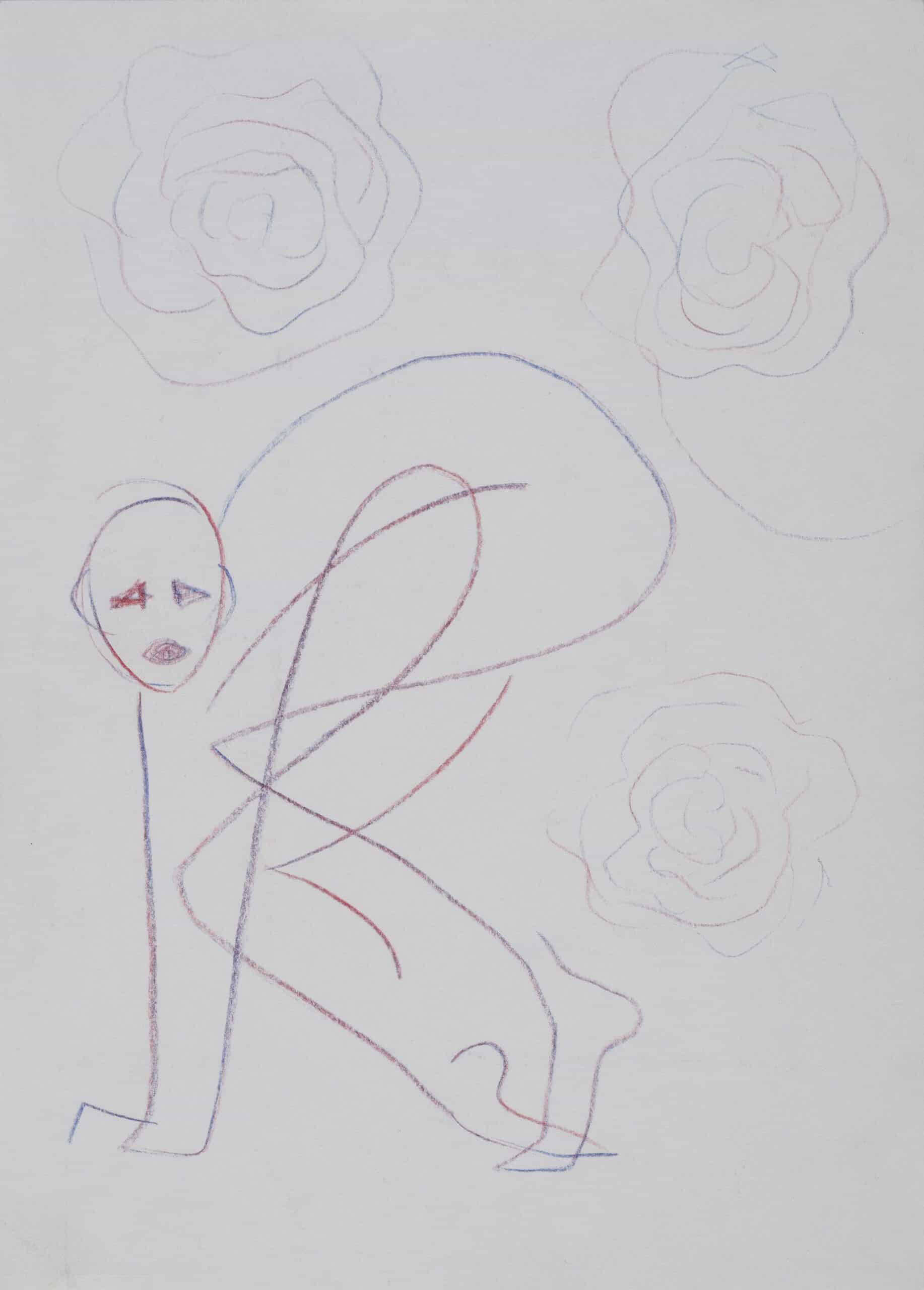
Self-Portrait, coloured pencil on paper, 2014
AM: You are quite illustrative in your poems, and on your paintings, you write.
ZB: I try not to write on the paintings. I do it very rarely, not wanting the text to overwhelm the image. One of the very few recent works of mine featuring text is the gouache on which I wrote, ‘Amliamet coxo.’ This inscription was borrowed from clothing at a market selling goods from China. A lot of textiles are produced in Asia emblazoned with pseudo-English sentences. I am often inspired by the use of this artificial language as ornament. Sometimes you can comprehend whole sentences or individual words. Their undertones are usually surprisingly sad, melancholic.
AM: The titles of your works sound gender neutral in English. In what way do issues of gender influence your art?
ZB: Gender certainly has an influence on my practice, both the painting and the literature. In my paintings, the primary human figure is always a woman. By implication, this is almost always me. Many of my paintings are limned with themes of female–male love. In my poetry, when a body appears, it is usually as a diabolical element, evil incarnate. In painting, it is perhaps imperceptible.
AM: This approach breaks with the strong tradition of body art and feminist art.
ZB: To tell the truth, I am unfamiliar with this tradition. I have never been interested in body art or feminist art.
AM: Does all of your work relate to your personal, intimate, and emotional life?
ZB: Yes, I think so.

Self-Portrait with Red Landscape, oil on linen, 2020
AM: Can you please tell us about how you work on a painting, how you apply your technique?
ZB: I almost never sketch on canvas or paper. When I do sketch, I have to erase and modify the sketch—the bother outweighs the convenience. Sometimes I know what I want to paint. I jot down in a notebook or into my phone ideas for pictures like, ‘high window, convex, falling onto a square,’ ‘a figure with a noose around its leg from a dude on a bench, and a distant landscape.’ I draw on a screen less frequently. More often, I approach a canvas or sheet of paper without a plan, grab the paint I want, and for a short while allow myself freedom of expression, out of which a scene emerges.
AM: Practice for you refers to your workspace, not skill set. What about artistic education?
ZB: As for the latter, I never completed any studies, and not for a moment have I studied art. I do not know how it is abroad, but I have the sense that painting at an Academy of Fine Arts in Poland is detrimental to artists. If they fail to deviate from their academic habits in time, it will take years for them to deterge their style of scholastic accretions. Of, for example, what I call ‘the paw.’ Post-art-school, artists like to show off their ‘paw,’ that they have artistic skill, that they can paint something hyper-realistically. Such painting carries a distinct whiff of the portfolio case. Of course, there are many artists who managed to escape before it was too late. I am not saying that studying is wholly negative. But there’s a lot you can do on your own, especially if you have the Internet. When it comes to technique, my father, who is also a painter, told me a few things, and Ola Waliszewska told me some more. But most of it came to me through doing.
AM: You often talk of your aversion to gallery spaces. What about them do you dislike?
ZB: I think that artists are becoming increasingly irritated with the standard ‘white cube.’ I think there are a few issues at play here. Boredom, shifting trends, a retreat from minimalism. White is associated with Modernism, which irks me. I am closer to fin-de-siècle architecture or that of the 1990s. I like galleries that have their own architecture, like La Maison de Rendez-vous, in Brussels. I like exhibitions in churches, restaurants, schools, cafes, as well as placing individual works in such spaces.

Love Crash, oil on linen, 2020
AM: How do you approach the arrangement of your exhibitions?
ZB: I have many unrealised configurations in my head and in my notebooks. Thus far, I haven’t had any solo exhibitions with a budget to allow for unconstrained arrangements. I attach great importance to the exhibition space. I believe that it should be thought out down to the last detail, and that it should concentrate one’s mind, like a sacred space. I like when artists fill entire galleries with their art, creating an architecture of exhibition. I like Francesco Clemente’s tents or Atelier E.B’s Fake Shop. Of course, good paintings will hold their own even on white walls above grey floors. But you can create better conditions for them. For me, art is sacred and deserves elevated treatment. Architecture is also very important. It saddens me that, in Poland, it is not afforded as much respect as in the Czech Republic, Germany, or Austria. At home, I think I have more books on architecture than on art.
AM: You once mentioned your fascination with Vienna circa 1900. And yet you also note that you distance yourself from Modernism.
ZB: I like the beginnings of Modernism. Adolf Loos. Frank Lloyd Wright. They had audacity. I like when architecture is given room for quirkiness. I have a list of buildings I would very much like to visit. There’s the Goetheanum, the Einstein Tower in Potsdam, the Melnikov House, the Sanctuary of Arantzazu, and countless churches and villas, mostly in Italy, and, yes, in Vienna. Vienna at the beginning of the twentieth century was a mecca. At that time, so many brilliant artists, writers, architects, and philosophers lived there. At the same time, this was a dark period. Many people committed suicide. Misogyny and anti-Semitism were not uncommon attitudes, even among brilliant creators. I am skeptical about our day’s fashionable political correctness and ‘cancel culture.’ We can end up banishing somebody gifted in this way.
AM: Do you mean to say that some of your works are on the edge of being politically incorrect?
ZB: God forbid, when I speak of ‘cancel culture’ I am not thinking of myself or anyone specific. I feel that the works of good artists do not, in general, have to remain within the bounds of political correctness. Political correctness and politics should not be applied to the arts, because art is a separate realm. Empyreal. Of course, I am discussing an ideal art, as it should be, and not as it is. If an artist performs, for example, in blackface or paints in menstrual blood, that is a political gesture. I do not consider that person an artist, but rather a schlockster. However, with the painting that interests me, criteria like political correctness should not be taken into account. It would be like telling Saint Augustine that, from an ecological point of view, his texts are rubbish. This makes no sense, because he’s a good writer. Far more interesting than political correctness are gauges such as good taste and common decency. Quite useful in art, yet they are neglected in Poland.
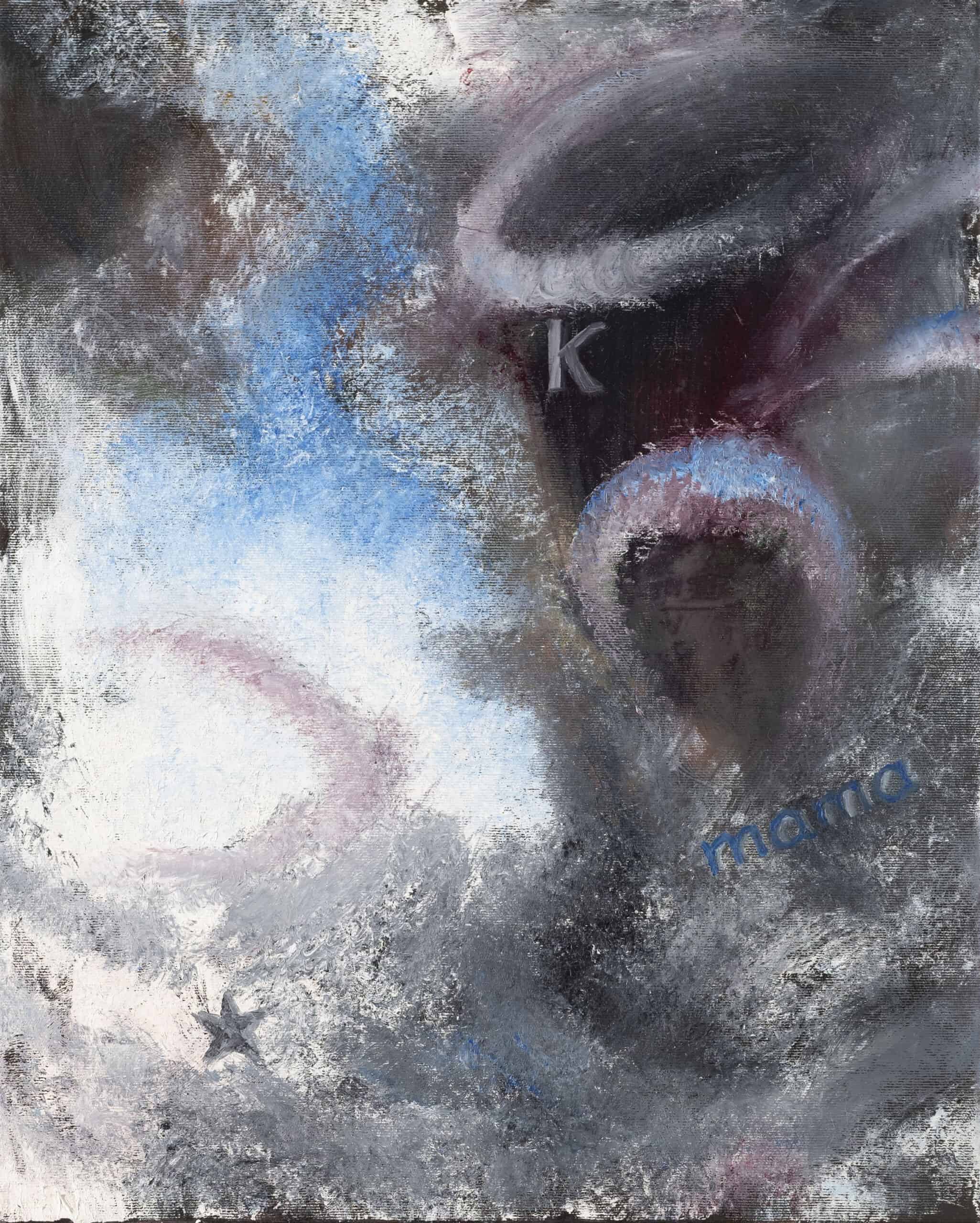
Last Few Seconds Before Dying, oil on canvas, 2020
AM: What then constitutes good taste and decency for you?
ZB: It is an internal brake that tells one that maybe there is no need to make a cross out of bloody tampons, or something like that. I thought we had long since put such stunts behind us, but it comes back, again and again, especially when the election is won by the right wing.
A while back, on the now defunct social-networking platform Grono.net, I posted a selfie of myself on a toilet with a bloody pad. For shame! But I was maybe thirteen at the time, so I think I may be forgiven. But when you’re an adult and do such things, it’s asinine. Seriously. Only children can get psyched about sacrilege and messing with taboos. In Murmur of the Heart, the main character says, ‘To blaspheme is to go on believing.’ I do not believe I am an escapist.
AM: How would you describe the connection between what you do and psychology?
ZB: I am interested in psychological processes happening in myself and other people. My texts often reveal the need to penetrate the minds of all people and animals, or at least to delve into another person. It scares me that everyone is alone with their feelings. Empathy doesn’t run deep.
AM: Psychoanalysis?
ZB: I prefer psychoanalysis in literature to psychoanalysis in practice. In Woolf or Proust. Psychoanalysis never interested me. I found Freud rather amusing.
AM: If not psychology, then perhaps spirituality? A religion of art?
ZB: Spirituality, absolutely. Religiousness, but without God. I believe in the possibility of experiencing illumination without creating the heavens. I experience moments of rapture which match accounts of religious rapture. Only I don’t subscribe to any notions of fraternity or an Absolute. Instead, they are moments of wonder at the sheer existence of the world. But it isn’t rational. Such states are best captured by a point from Wittgenstein’s Treatise: ‘6.44: It is not how things are in the world that is mystical, but that it exists.’ In culture, I search for different atheistic traces of illumination, but there aren’t many. It seems to me that Białoszewski had similar ecstatic experiences. During childhood, I was a little devotee, and I feel that my mind yearns for it. For prayer, for faith. I would note that I don’t mean any esoteric or junkie stuff. I am afraid of drugs, and avoid them. I fear that after using some drug, I will see God and begin painting fractals and mandalas. Or I will stop painting altogether and become an eco-mama.
AM: In your art, you combine elements of traditional artistic and literary technique with social-media image creation. Is your Instagram, and, more broadly, you and your life, also art?
ZB: No. Instagram is Instagram. A vanity market, Satan’s church. It’s fun, a promotional tool, a messenger. I somewhat regret joining, because now the curators think that every selfie is an artistic statement. I do not combine elements of traditional artistic practice with creating an online personality. I have never shown social-media content in exhibitions, although I have had several proposals to do so. In my exhibitions, there is solely art, and sometimes poetry. Myself and my life are likewise not art. At most, they contribute to a biography of the artist.
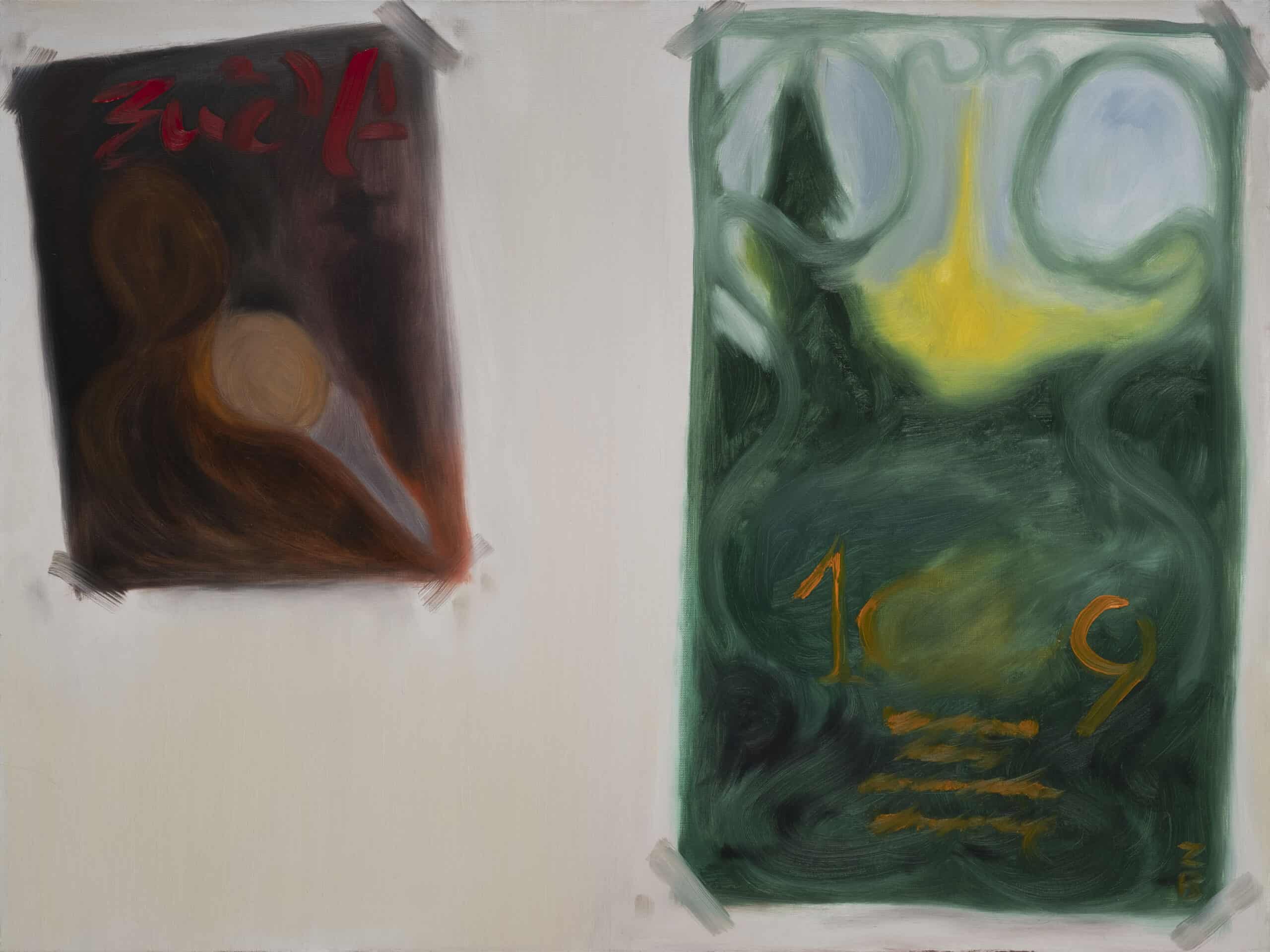
Fake Posters, oil on linen, 2020
Self-Portrait, from 2014, opened me up to drawing. It had been some time since I had been artistically active. I was writing a novel. I was thinking that I would finish my Philosophy and Cognitive Science studies and become a writer. All at once I began to draw, and thanks to this newfound freedom, I realised that in art I could achieve something of interesting value apart from literary endeavour.
Self-Portrait with Red Landscape is a painting of longing. I imagined the one I was missing, who was very far away from me, beholding beautiful vistas. I imagined the landscape they looked out upon. I wondered if, as they beheld this landscape, they were thinking of me. On the right side of the canvas you see my figure, entrapped by yearning and obsessive thoughts. It is a landscape of bloody colours, for such is the hurt of love.
Love Crash is a blurred image. Expression, which is usually more important to me than anecdote, deprives it of legibility. It depicts a person being hit by a car (which is also somewhat doglike) in front of a walking couple. This situation is one of double humiliation, for the person who has been hit is in love with one of the strollers. I added the Eiffel Tower to complete the composition. Plus, the tautology appealed to me: setting a love scene in the city of love. I have never been to Paris. The title of the painting is taken from Brume.
Last Few Seconds Before Dying is a depiction of a pre-death vision. I painted it by applying oil paint to crumpled foil, and then from the foil to the canvas. Afterwards, I added arches. There are those who see angels or other figures in them. To me, they are abstract forms. In the mind of the dying person there are residual thoughts or symbols: a star, a letter, the word ‘mama,’ often repeated in anguish.
Fake Posters is one of my works showing fictional graphic-design projects. The direct inspiration was the video game The Sims, in which you see simulated posters with tag lines in the ‘Simlish’ language. There are two blurred objects in the painting. One is dark, like a poster for a horror film. There is a suggestion of figures: a mother with a child, a mysterious man in a hat. The second depicts a sunrise in an Art Nouveau setting. A date is visible, perhaps 1909. I also painted a few ‘ersatz’ book covers, with illegible titles, simplified layouts, and nonexistent authors. Acquiring this painting would be a good option for somebody who wants to have something on the wall but cannot decide what. The posters are affixed to the wall with transparent tape. Near the tape, I painted smears left by dirty fingerprints.
Baby Shower is gouache on paper. I have never attended such a gathering. I am uneasy about a celebration being held in honour of one who has not yet been born. I assume that this tradition is mostly about providing economic support for the young mother-to-be, who collects a layette for her child. But I feel it should take place after the birth. A woman may have a miscarriage. Were I to become a mother, I would be fearful of such premature optimism, of jinxing. I have been aware for some time that the news that someone is expecting a baby saddens me. I worry for young mothers. This gouache speaks of those anxieties.
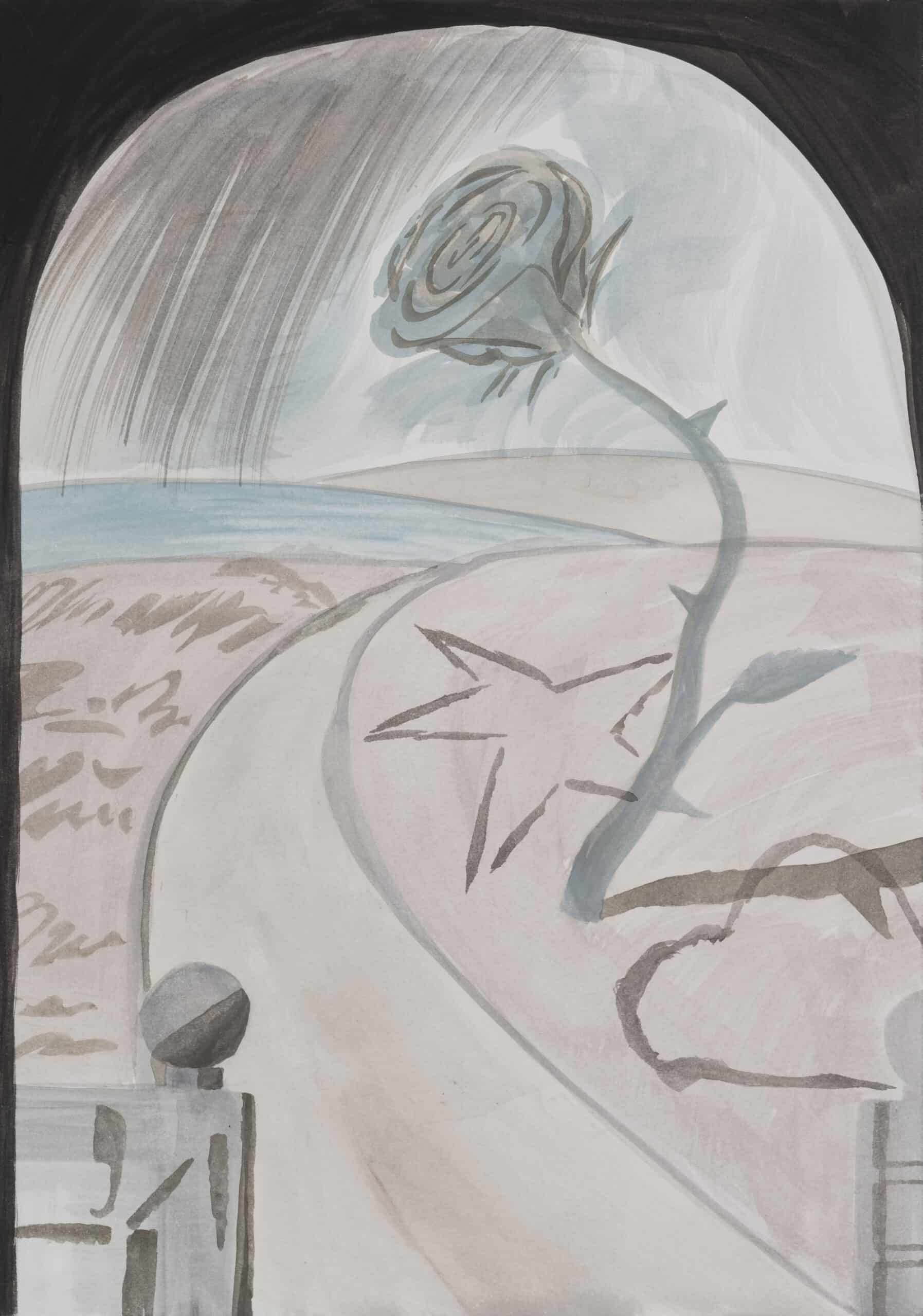
Baby Shower, gouache on paper, 2019
This conversation is the result of work on the exhibition I Do Not Share with Anyone, presented as a part of Krakow Photomonth 2020. Information about the manifestos, presentations, conversations, and works of art contributed by the participating artists, as well as an exhibition catalogue in PDF format, will be available at: https://photomonth.com/en/portfolio/i-do-not-share-with-anyone/.
Interviewed by Adam Mazur
Translated by Stefan Lorenzutti and Joanna Osiewicz-Lorenzutti








